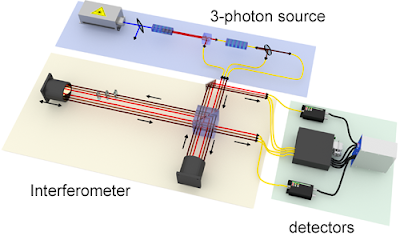Quantum interference effects lie at the heart of technologies that promise radically new capabilities for sensors, secure communications, and computing. Most existing experiments and applications rely on one photon interfering with itself, or two photons interfering with each other. However, the interference of a larger number of particles leads to a richer variety of phenomena, and may enable more sophisticated applications. Now, two independent groups, the first led by Thomas Jennewein at the University of Waterloo, in Canada [1], the second by Ian Walmsley at the University of Oxford, in the UK [2], have been able to isolate and observe, for the first time, “genuine” interference between three photons, that is, an effect deriving from the quantum interference of three photons that does not originate from two-photon or single-photon interference. The two studies provide new tools for controlling multiphoton interference, which may help researchers design new fundamental tests of quantum mechanics, quantum-communication protocols, and powerful quantum simulators.
The quintessential example of multiphoton quantum interference is the Hong-Ou-Mandel (HOM) effect, first observed in 1987. In an HOM experiment [3], two independent photons coming from different directions impinge on a 50:50 beam splitter. If the two incoming photons are distinguishable, the outgoing photons will split equally between the two exit ports of the splitter. However, if the two photons are identical and arrive simultaneously, the quantum-mechanical wave functions will interfere, and the two photons will always exit through the same port, even though each of them has an equal probability of exiting through both ports.
APS Physics Viewpoint: Photonic Hat TrickRobert Sewell, The Institute of Photonic Sciences, Av. Carl Friedrich Gauss, 3, 08860 Castelldefels (Barcelona), SpainApril 10, 2017• Physics 10, 38

Comments